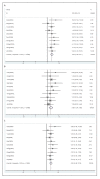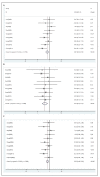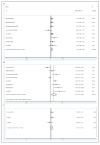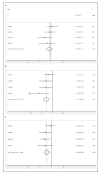Association between polymorphisms in XRCC1 gene and clinical outcomes of patients with lung cancer: a meta-analysis
- PMID: 22339849
- PMCID: PMC3305620
- DOI: 10.1186/1471-2407-12-71
Association between polymorphisms in XRCC1 gene and clinical outcomes of patients with lung cancer: a meta-analysis
Abstract
Background: X-ray repair cross-complementing group 1 (XRCC1) protein plays an important role in the repair of DNA damage and adducts. Single nucleotide polymorphisms (SNPs) of XRCC1 are suspected to have some relationship with response to chemotherapy and overall survival of lung cancer. This meta-analysis aimed to summarize published data on the association between the commonest SNPs of XRCC1 (Arg194Trp, C > T, rs1799782 and Arg399Gln, G > A, rs25487) and clinical outcome of lung cancer patients.
Methods: We retrieved the relevant articles from PubMed, EMBASE and the China National Knowledge Infrastructure (CNKI) databases. Studies were selected using specific inclusion and exclusion criteria. Primary outcomes included objective response (i.e., complete response + partial response vs. progressive disease + stable disease) and overall survival (OS). Odds ratio (OR) or hazard ratio (HR) with 95% confidence interval (CI) were estimated. All analyses were performed using the Stata software.
Results: Twenty-two articles were included in the present analysis. XRCC1 Arg194Trp and Arg399Gln polymorphisms were significantly associated with response to treatment in lung cancer patients. Patients with C/T genotype, T/T genotype and minor variant T allele at Arg194Trp were more likely to respond to platinum-based chemotherapy compared with those with C/C genotype (C/T vs. C/C: OR, 2.54; 95%CI, 1.95-3.31; T/T vs. C/C: OR, 2.06; 95%CI, 1.39-3.06; C/T+T/T vs. C/C: OR, 2.42; 95% CI, 1.88-3.10). For XRCC1 Arg399Gln, G/A genotype, A/A genotype and minor variant A allele were associated with objective response in all patients (G/A vs. G/G: OR, 0.67; 95%CI, 0.50-0.90; A/A vs. G/G: OR, 0.43; 95%CI, 0.25-0.73; A/A+G/A vs. G/G: OR, 0.63; 95%CI, 0.49-0.83). Both G/A and A/A genotypes of XRCC1 Arg399Gln could influence overall survival of lung cancer patients (G/A vs. G/G: HR, 1.23; 95%CI, 1.06-1.44; A/A vs. G/G: HR, 2.03; 95%CI, 1.20-3.45). Interaction analysis suggested that compared with the patients carrying C/T+T/T genotype at XRCC1 194 and G/G genotype at XRCC1 399, the patients carrying 194 C/C and 399 G/A+A/A or 194 C/C and 399 G/G genotype showed much worse objective response.
Conclusions: Genetic polymorphisms in XRCC1 gene might be associated with overall survival and response to platinum-based chemotherapy in lung cancer patients.
Figures





Similar articles
-
XRCC1 Arg399Gln and clinical outcome of platinum-based treatment for advanced non-small cell lung cancer: a meta-analysis in 17 studies.J Zhejiang Univ Sci B. 2012 Nov;13(11):875-83. doi: 10.1631/jzus.B1200083. J Zhejiang Univ Sci B. 2012. PMID: 23125080 Free PMC article. Review.
-
Polymorphisms in the XRCC1 gene are associated with treatment response to platinum chemotherapy in advanced non-small cell lung cancer patients based on meta-analysis.Genet Mol Res. 2014 May 16;13(2):3772-86. doi: 10.4238/2014.May.16.1. Genet Mol Res. 2014. PMID: 24938464
-
Pharmacogenetic Association between XRCC1 Polymorphisms and Response to Platinum-Based Chemotherapy in Asian Patients with NSCLC: A Meta-Analysis.Biomed Res Int. 2020 Oct 22;2020:3520764. doi: 10.1155/2020/3520764. eCollection 2020. Biomed Res Int. 2020. PMID: 33150172 Free PMC article.
-
Pharmacogenetic role of XRCC1 polymorphisms on the clinical outcome of gastric cancer patients with platinum-based chemotherapy: a systematic review and meta-analysis.Genet Mol Res. 2014 Mar 6;13(1):1438-46. doi: 10.4238/2014.March.6.2. Genet Mol Res. 2014. PMID: 24634242
-
No association between XRCC1 polymorphisms and survival in non-small-cell lung cancer patients treated with platinum-based chemotherapy.Cancer Biol Ther. 2010 Nov 1;10(9):854-9. doi: 10.4161/cbt.10.9.13238. Epub 2010 Nov 1. Cancer Biol Ther. 2010. PMID: 20814250
Cited by
-
DNA repair, genome stability and cancer: a historical perspective.Nat Rev Cancer. 2016 Jan;16(1):35-42. doi: 10.1038/nrc.2015.4. Epub 2015 Dec 15. Nat Rev Cancer. 2016. PMID: 26667849 Review.
-
A systematic review and meta-analysis of somatic and germline DNA sequence biomarkers of esophageal cancer survival, therapy response and stage.Ann Oncol. 2015 Apr;26(4):624-644. doi: 10.1093/annonc/mdu449. Epub 2014 Sep 11. Ann Oncol. 2015. PMID: 25214541 Free PMC article.
-
XRCC1: a potential prognostic and immunological biomarker in LGG based on systematic pan-cancer analysis.Aging (Albany NY). 2024 Jan 12;16(1):872-910. doi: 10.18632/aging.205426. Epub 2024 Jan 12. Aging (Albany NY). 2024. PMID: 38217545 Free PMC article.
-
The relationship between genetic variants of XRCC1 gene and lung cancer susceptibility in Chinese Han population.Med Oncol. 2014 Sep;31(9):157. doi: 10.1007/s12032-014-0157-7. Epub 2014 Aug 22. Med Oncol. 2014. PMID: 25146668
-
Association between polymorphisms in XRCC1 gene and treatment outcomes of patients with advanced gastric cancer: a systematic review and meta-analysis.PLoS One. 2014 Jan 21;9(1):e85357. doi: 10.1371/journal.pone.0085357. eCollection 2014. PLoS One. 2014. PMID: 24465544 Free PMC article.
References
Publication types
MeSH terms
Substances
LinkOut - more resources
Full Text Sources
Medical

